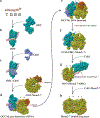Origins of DNA replication in eukaryotes
- PMID: 36640769
- PMCID: PMC9898300
- DOI: 10.1016/j.molcel.2022.12.024
Origins of DNA replication in eukaryotes
Abstract
Errors occurring during DNA replication can result in inaccurate replication, incomplete replication, or re-replication, resulting in genome instability that can lead to diseases such as cancer or disorders such as autism. A great deal of progress has been made toward understanding the entire process of DNA replication in eukaryotes, including the mechanism of initiation and its control. This review focuses on the current understanding of how the origin recognition complex (ORC) contributes to determining the location of replication initiation in the multiple chromosomes within eukaryotic cells, as well as methods for mapping the location and temporal patterning of DNA replication. Origin specification and configuration vary substantially between eukaryotic species and in some cases co-evolved with gene-silencing mechanisms. We discuss the possibility that centromeres and origins of DNA replication were originally derived from a common element and later separated during evolution.
Keywords: DNA replication; epigenetic inheritance; evolution; origin recognition complex.
Copyright © 2022 Elsevier Inc. All rights reserved.
Conflict of interest statement
Declaration of interests The authors declare no competing interests.
Figures




References
-
- Koduru SK (2019). Recent Developments in Applied Microbiology and Biochemistry. 335–347. 10.1016/b978-0-12-816328-3.00024-6. - DOI
-
- Grogan DW (2013). Brenner’s Encyclopedia of Genetics (Second Edition). In Archaea, pp. 180–182. 10.1016/b978-0-12-374984-0.00092-9. - DOI
-
- Sessions SK (2013). Brenner’s Encyclopedia of Genetics (Second Edition). In Genome Size, pp. 301–305. 10.1016/b978-0-12-374984-0.00639-2. - DOI
Publication types
MeSH terms
Substances
Grants and funding
LinkOut - more resources
Full Text Sources

